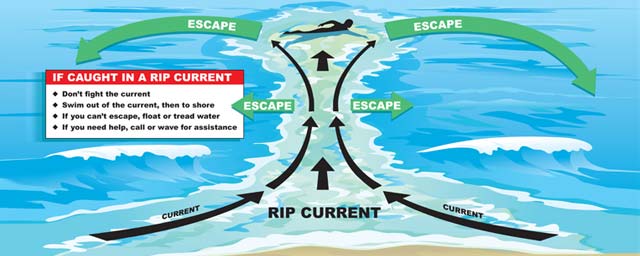
Rip currents: Staying safe
March 25, 2018There are many dangers that lay waiting when it comes to the oceans we flock to for vacation and relaxation. As we all meander through life, we are faced with certain dangers that are often unforeseeable. To be more precise, when it comes to the ocean, most of these dangers are not visible to the human eye. Rip currents: Staying safe! Everyone has heard of the dangers that wait on the shorelines. Without a doubt, it’s valuable information that all beach goers should be made aware of before tackling any vacation.
The most common dangers that parents want their children aware of is the forces that can pull you away from the shore or underwater. Often people will use the term “riptide” in explaining this phenomenon. That is an incorrect term. The “rip” associated term is correctly call a rip current. There is no direct relation between changing tides and rip currents. Not to be confused with undertow – which is an entirely different threat altogether – rip currents are a very real danger to even the strongest of swimmers when near a wave breaking.
The National Weather Service had reported over 30 surf zone drownings in the coastal regions of the United States. Over 50% of these fatal events were a direct result of swimmers falling victim to the power of a rip current.
Yes, there is much confusion over what to call the forces generated by waves. However, there is far more confusion on how to escape the danger of the rip currents. It’s been widely and incorrectly accepted that rip currents are the phenomenon that drag swimmers beneath the surface of the ocean. To be precise, rip currents pull swimmers away from the shore out beyond where the surf breaks. If you are a swimmer and feel you are being pulled out to sea, the instinctive idea that first occurs is – naturally – to swim back towards the shore. Unfortunately, swimming against a current that strong is an effort made in vain. Fighting these currents to swim back to the shore will only exhaust a swimmer. Hence, the reported percentage of drowning causes lean towards rip currents.
“What do I do if I get caught up in a rip?” Using your line of sight, pick a line which is parallel to the shore and swim along this line to escape the path of the rip current. Typically, the widest of rip currents are only around 100 feet—not a long distance for even a tired swimmer to cover to get back to safety. If people can lift a small car in rushes of adrenaline to save a life, surely, we can swim 100 feet to save our own. Fear, panic, and lack of knowledge are the greatest threat to our survival in this situation.
Using your line of sight, pick a line which is parallel to the shore and swim along this line to escape the path of the rip current.
Rip currents: Staying safe
As with any danger, it’s best to be able to identify it before you become vulnerable to its reach. Standing on the shore, look out across the panoramic area of where you are going to be in the water. Find a channel of the smoothest identifiable surface water where the waves seem to be lower. Another identifier would be lesser occurring whitecaps at the breaking point of the waves. If you see either of these, it is more likely than not that it is a rip current. Naturally, avoid this area. Keep your family and friends informed of these dangers as this years’ beach season approaches. Let’s see if we can get the numbers of lives needlessly lost to the sea at the lowest number possible. Happy vacationing and swimming!
Find a channel of the smoothest identifiable surface water where the waves seem to be lower. Another identifier would be lesser occurring whitecaps at the breaking point of the waves. If you see either of these, it is more likely than not that it is a rip current.
Tags: beach, drowning, rip, rip currents, safety, swimming, test, tide
Categorised in: Tips & FAQs
